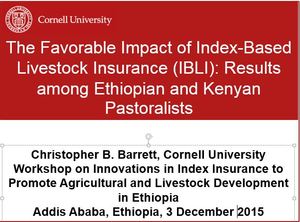The changing face of pastoral systems in grass dominated ecosystems of Eastern Africa
All eastern Africa is in the tropics, but its grasslands cover a very wide range of altitudes. Extensive grasslands are mostly in arid and semi -arid zones. The area is subject to droughts and a high degree of pastoral risk. Potential vegetation is largely desert and semi-desert, bush and woodland, with only a small area of pure grassland, but the grass -dominated herbaceous layer of the other formations is very important for wildlife and livestock; 75 percent of eastern Africa is dominated by grasslands, often with a varying amount of woody vegetation.
The economics of optimal health and productivity in smallholder livestock systems in developing countries
Livestock kept or produced in smallholder farming systems are an important component of the agricultural economy in the developing world. The role of livestock on smallholder farms varies widely, providing draught power for crop production or as a production activity for subsistence needs or market sale under systems ranging from extensive pastoralist to intensive, peri-urban feeder and dairy systems.
The potential benefits and challenges of agricultural animal biotechnology to pastoralists
The livelihoods of pastoralists revolve around their indigenous livestock. Combining high
production with disease resistance using genetic engineering is a biotechnological intervention
hailed by some as a promising avenue to mitigate food insecurity and poverty. Considerable
human and financial resources have already been devoted to exploring this option. However, the
challenges are enormous. It is unlikely that such livestock would survive in the harsh ecosystems
The role of risk management in pastoral policy evaluation and poverty reduction
The sedentarisation process of the Bahima in Uganda: an emic view
The traditional lifestyle of nomadic pastoralists is vanishing rapidly, because of human population growth which often leads to land scarcity or political pressure on pastoralists to settle. The sedentarisation of the Bahima pastoralists in Western Uganda started in the 1940s and is still going on. In this study former nomadic cattle keepers, who have settled with their families, were interviewed in order to document the decision to settle and the subsequent changes in the lifestyle of these people. All interviewees expressed their satisfaction with their sedentary life.









